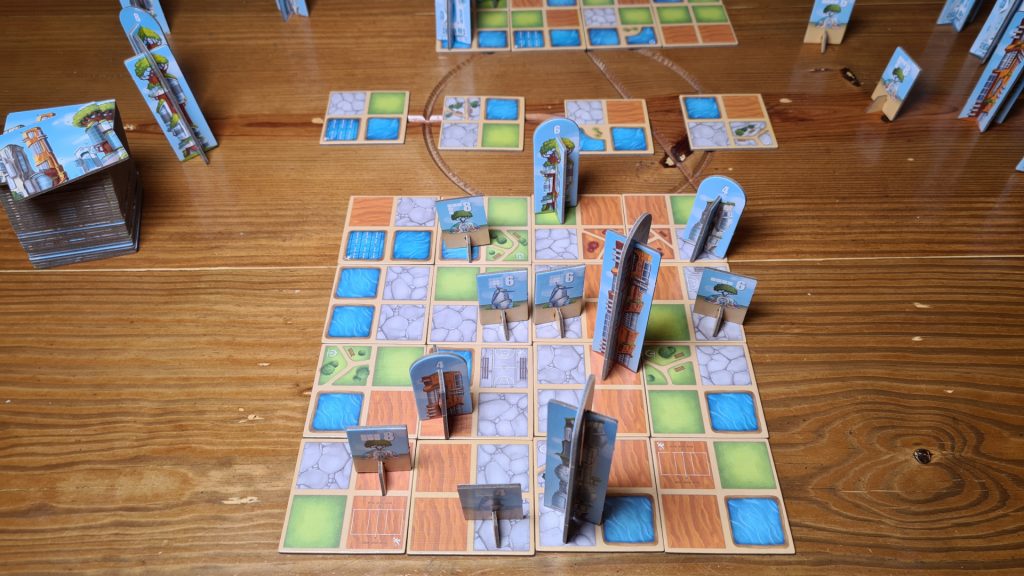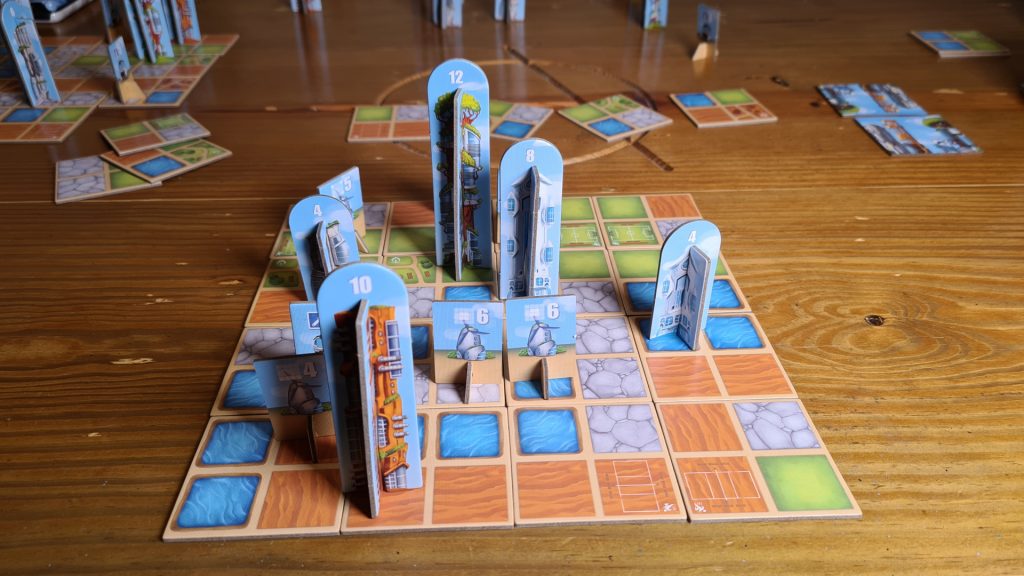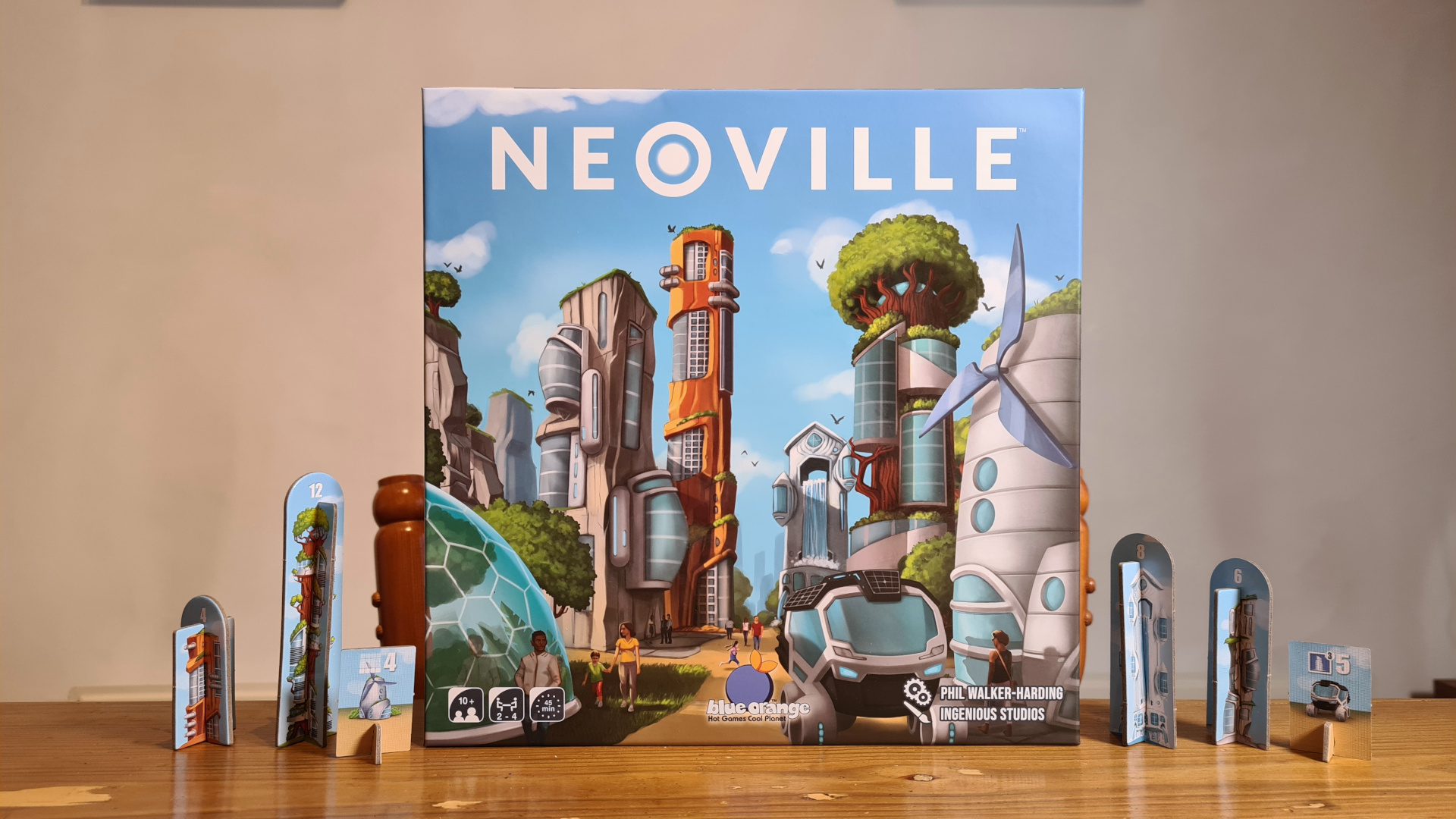Neoville is the brand new tile placement, city building, board game from Blue Orange Games and Phil Walker-Harding. The game sees 2 – 4 players become architects, tasked with constructing a city that balances skyscrapers, utilities and the natural world. With tiles, players will build a 4×4 city and try to score points for how well it balances the needs of humans with nature. However, will the skyscrapers make the game soar into success? Let’s find out!
Before the game begins, players take all skyscrapers from the box, sorting them into the four types – waterfall, earth, forest and stone. Removing the 4 equity tiles, the stack of tiles is shuffled and placed in the middle of the table. Each player in turn order takes the appropriately numbered equity tile, with everyone then dealt two more tiles from the stack. A market of 4 tiles is then made, flipped from the stack. Two of the three utility types are chosen, with 5 of each randomly taken out of the box, with the game then ready to begin.
Starting with the player with the numbered 1 equity tile, play goes around the table clockwise. On a turn the active player must play a tile from their hand of three, optionally place a structure and then gain a tile from the market. The first tile is just placed down, with future tiles needing to be placed adjacent to previous tiles. A player’s city cannot grow wider or taller than a 4×4 city, ending as a perfect square. The terrains on the tiles do not matter for placement, though they do for scoring.
Once the tile is played the player may add a single skyscraper or a utility to the just placed tile. Skyscrapers are placed onto matching terrain, so a waterfall skyscraper must be placed onto an empty water space. Each skyscraper has a number on it, which also approximately corresponds with how tall it is. This number only comes into effect at the end of the game but it is how many points it will score if it’s on a district of at least that size. For example, the 6 stone skyscraper would score the player 6 points if at the end of the game the stone district it’s built on is 6 spaces or bigger.

Instead, a player could build one of the available utilities. These buildings don’t directly refer to the terrain type they are built on. While a player can only build 1 skyscraper in each district, most utilities don’t normally clash. Windmills score based on where the tile is on the player’s 4×4 grid at the end of the game. Domes, which cannot be built in the same district, score based on the shape of the district. Ecomobiles score based on what’s been built in the row and column it’s constructed in – e.g. wanting at least 3 skyscrapers in the same row and column as it.
Of course there is a bit of a twist. Players will score for the skyscrapers and utilities they build if they successfully complete them – with the points being the denoted number. However, players will lose that number of points if they fail to complete the requirements. Even if a player has an 11 space sized zone a 12 numbered skyscraper placed there would lose them the full 12 points. After a player has placed a tile and optionally placed a structure, they choose a tile from the market and play then moves onto the next player. The game ends when everyone has finished their 4×4 city – so everyone will have 16 turns. Points are then awarded for successfully completed skyscrapers/utilities, lost for incomplete ones, a bonus of 5 points is separately awarded for whomever has the most parks and most sports facilities in their city – with the winner whoever has the most points.
Phil Walker-Harding titles are often simple to play and Neoville continues this. With simple turns, teaching the game to new players is extremely easy. There’s no issues of working out what you can do, allowing players to enjoy placing their tiles and creating a city. A touch of complexity is added into the mix by the way utilities score, though for a simple game using the windmills and biodomes keeps it firmly a family friendly experience.
Each turn there is the drive to use the optional action of adding a skyscraper or utility. A turn without adding the opportunity for more points can feel wasted. This drives up the risk as players then struggle to complete all of the districts, whilst potentially forgetting the utilities they’ve placed – all which could lose them points. It’s not quite pushing your luck but knowing when to stop and just take a tile without adding something onto it is key.

There is a bit of variety added into Neoville via including only two of the three utilizes each game, and only 5 of said utilizes randomly picked from the box. The different types score differently so there’s a slight change of how you might want to connect tiles as a result. There’s less change within the individual types, such as the windmills which just change which tiles they score on. A few more of these utility types could have shaken things up more, and there’s certainly the opportunity for them to score based on what terrain types surrounds them or something similar.
While it is a little hard to shuffle the large stack of tiles, the tiles themselves are of good quality. The different terrain types are all easily distinguishable from each other, and the zones with parks or sports centers are visibly different from the regular spaces. This makes it super simple to glance at your growing city in front of you and determine if areas are big enough, or still need those few extra spaces of terrain in a district in order to score. Adding the skyscrapers and utilities gives the players’ cities that much needed flair, via injecting some verticality – though players do then sometimes need to lean to look around tall towers to see the smaller ones behind.
Neoville is one of Phil Walker-Harding’s more streamlined designs. Skyscrapers and utilities add interesting ways to score points, though are intuitive objectives that will work well with a family audience. Turns are fast, with the game rocketing around the table, which limits downtime – keeping everyone invested from the get go. The cities that are created aren’t always high scoring but with the flairs of skyscrapers and utilities they look good. Neoville is a pleasant tile laying game, with choices on every turn – ideal for families and as a gateway style experience.
(Editor’s Note: Neoville was provided to us by Coiledspring Games for the review. The game is currently available from local board game stores! Find your local store here.)

